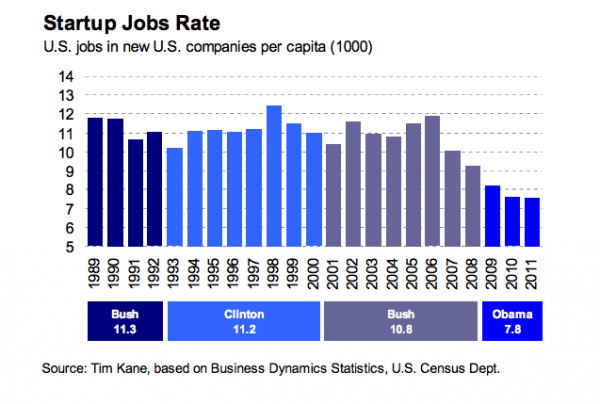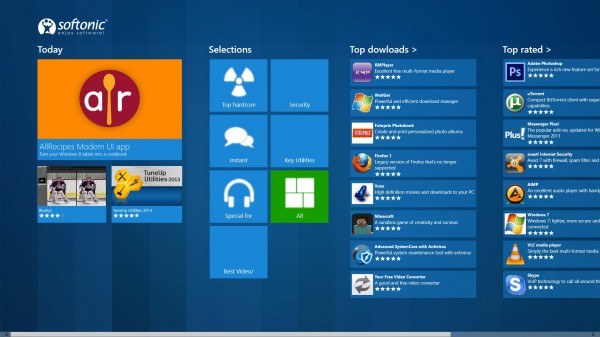
As I’ve written many times before, small companies and especially new companies are what create nearly all of the net new jobs in America, yet a new study released last week by the Hudson Institute suggests the rate of job formation by new firms is down dramatically in recent years, from an average of 11 new startup jobs per 1,000 workers at a peak in 2006 down to 7.8 new startup jobs per 1,000 workers in 2011 -- a 29 percent decline. So is the startup economy losing its oomph and should we be worried? No the startup economy isn’t losing its oomph but yes, it’s time to worry.
The Hudson Institute study was written by the think tank’s chief economist Tim Kane. He notes with concern this downward trend in startup job formation but his study doesn’t attempt to explain it, leaving that for the future. He’s not above, however, mentioning the likely negative impact of increased regulation, especially from the impending Affordable Care Act, AKA Obamacare.
There’s a lot to think about here and a lot of good research yet to be done, but I know more startup founders than the average Joe and I don’t think many of the founders I know factored Obamacare, with its 2014 inception date, into their 2011 business decisions.
There are, I think, two much more significant effects being felt here. One is the nature of job formation evolved over time and labor statistics haven’t yet evolved to keep pace. The other effect is the simple unavailability of credit despite low interest rates.
One might expect entrepreneurship to be rising in the United States, especially with lower fixed costs for modern service-based startups, as well as other advantages, such as higher levels of human capital, higher incomes, and the rising availability of funding through bank and venture capital.
These words are from the short preface to Tim’s paper. Let’s consider each of his points in turn:
1. Lower fixed costs for modern service-based startups. This is true and is one of the significant effects I mentioned above. If your new startup is built entirely in, say, Amazon’s cloud, there’s a lot less to be done in terms of logistics and infrastructure, so you probably save a job or two, which could account for most of the effects noted in the study.
2. Higher levels of human capital. I think this means more qualified people looking for work which is again true despite the H1B lobbyists claiming otherwise.
3. Higher incomes. Whose? Is your income higher so you’ve decided to start a new company? Certainly there are parts of the population that are doing better than ever. It would be interesting to learn whether those people are the ones starting new companies.
4. The rising availability of funding through bank and venture capital. Say what? This is simply not the case. Venture capital represents a relatively small proportion of the funding base for new company formation. Most new company founders in America have never met a venture capitalist. And while it is true the banks are stuffed to the rafters with cash to loan thanks to easy terms from the Federal Reserve, they simply aren’t lending money to entrepreneurs, who tend to be people with big dreams and small credit ratings.

What’s at work here to stifle company formation is lack of credit combined with some increases in efficiency that allow companies to do more with less.
Part of the issue is the definition of startup, which to our crowd means new technology companies but to the Bureau of Labor Statistics also means new Arby’s franchises. The current credit crunch makes this a particularly bad time to be getting into the roast beef sandwich game.
It’s this lack of credit that should worry us because the Obama Administration has shown no ability whatsoever to fix this problem, though the JOBS Act may finally help when it kicks-in next year.
Tim Kane is my friend, his report is interesting as far as it goes and it should spark a lot more inquiry from economists, but I think what it mainly represents is a love letter to Presidential nominee Mitt Romney, trying to give some economic ammunition to a candidate on the ropes.
Reprinted with permission
Photo Credit: Catalin Petolea/Shutterstock







 If you have a newish iOS device -- whether it’s iPhone, iPad or iPod touch -- there’s a good chance you have already upgraded to iOS 6 and are using it now. According to a study by
If you have a newish iOS device -- whether it’s iPhone, iPad or iPod touch -- there’s a good chance you have already upgraded to iOS 6 and are using it now. According to a study by 








 As you can see from this side-by-side comparison, the photo-positive scan has much richer colors than the smartphone negative scan. It almost looks like an artificial aging filter was added. So if you happen across a pile of old photo negatives that you don't want to pay to process, you can absolutely use your smartphone to create positives, but without the benefit of knowing how the colors were supposed to be reproduced, your final result might not look as good as an actual print would.
As you can see from this side-by-side comparison, the photo-positive scan has much richer colors than the smartphone negative scan. It almost looks like an artificial aging filter was added. So if you happen across a pile of old photo negatives that you don't want to pay to process, you can absolutely use your smartphone to create positives, but without the benefit of knowing how the colors were supposed to be reproduced, your final result might not look as good as an actual print would. 





